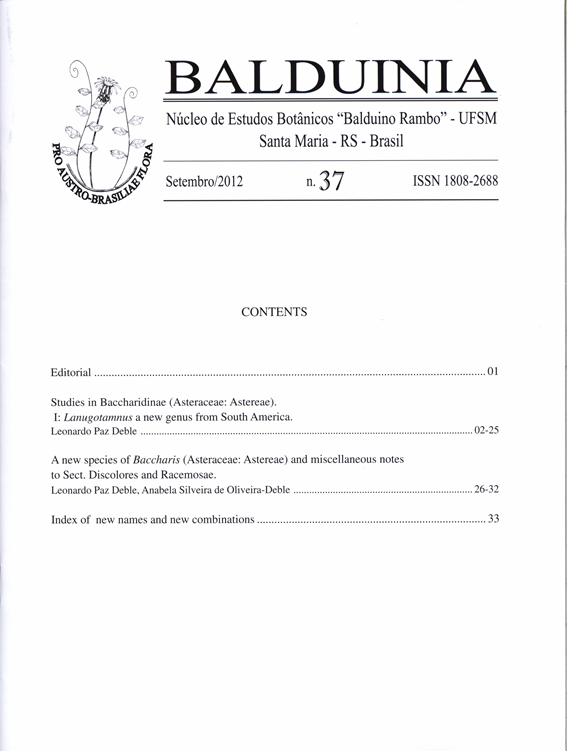A new species of Baccharis (Asteraceae: Astereae) and miscellaneous notes to Sect. Discolores and Racemosae
DOI:
https://doi.org/10.5902/2358198013973Palavras-chave:
Biodiversity, section Discolores, section Racemosae, Serra Geral, TaxonomyResumo
Bacccharis floccosa is described, illustrated and have their taxonomic affinities discussed. The new species belongs to section Discolores DC. emend. Cuatrec., and can be easy segregated of all species of this section by a combination of the following features: strongly discolorous leaves, pistillate capitula with 7-9 flowers, and corolla of staminate flowers at the apex clothed by filiform trichomes concentrated at the apex of the tube. The new species is related to sympatric species Baccharis nummularia Malme, but differs by its robust habit (1.5-2.5 m vs. 0.3-0.8 m high), attenuate leaves (vs. rounded), and smaller pistillate capitula, with peduncles densely floccose pubescent (vs. peduncles sericeous pubescent). From the allopatric species Baccharis phylicoides Kunth the new species differs by number of pistillate flowers per capitulum (7-9 vs. 13-65), indumentum on abaxial surface of the leaves consisting of a compact and dense layer (vs. loose layer), and corolla of staminate flowers densely clothed by filiform trichomes concentrated at the apex of the tube. Baccharis floccosa displays range of geographical distribution smaller than 1,000 km2, beeing considered endangered species, according with the criteria of IUCN. Baccharis nummularia is added to section Discolores and a key to segretate the species of the section Discolores is given. Furthermore morphological features to set apart the sections Discolores and Racemosae Ariza are supplied, as well as Baccharis uncinella DC. and B. longittenuata A.S. Oliveira are positioned into the section Racemosae.
Downloads
Downloads
Publicado
Como Citar
Edição
Seção
Licença
Autores que publicam nesta revista concordam com os seguintes termos:
- Autores mantém os direitos autorais e concedem à revista o direito de primeira publicação, com o trabalho simultaneamente licenciado sob a Licença Creative Commons Attribution (CC-BY-NC-SA) que permite o compartilhamento do trabalho com reconhecimento da autoria e publicação inicial nesta revista, não comercial e compartilha igual.
- Autores têm autorização para assumir contratos adicionais separadamente, para distribuição não-exclusiva da versão do trabalho publicada nesta revista (ex.: publicar em repositório institucional ou como capítulo de livro), com reconhecimento de autoria e publicação inicial nesta revista.
- Autores têm permissão e são estimulados a publicar e distribuir seu trabalho online (ex.: em repositórios institucionais ou na sua página pessoal) a qualquer ponto antes ou durante o processo editorial, já que isso pode gerar alterações produtivas, bem como aumentar o impacto e a citação do trabalho publicado (Veja O Efeito do Acesso Livre).







